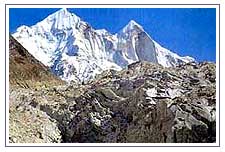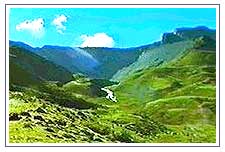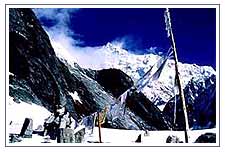Symbolic representations of religion marked wealth and social status, and
set the rulers apart from the people
The Natural And The Abstract
Since time immemorial, symbols reflecting
ideology and social order have been used by human societies. Archaeologists
and ancient scholars affirm that this tradition goes back to the Paleolithic
period, the earliest stage in the evolution of the Homo Sapiens.

However, it was only with the rise of urban civilization the world over
that one sees as almost theatrical increase in the production and the use of
symbolic objects. The symbols of the Indus Valley civilization were also
produced in the context of cities. The innumerable finds of symbolic
representations and objects in the different cities of Indus civilization
are both exotic and mind boggling. Unfortunately, the exact and specific
meaning of Indus symbols eludes us because of the absence of written texts.
Many scholars tried to co-relate the Indus symbols and ritual objects with
those used by the later Hindu and Buddhist cultures. However, the inability
to decipher the Indus script clouds any final conclusion and neither the
Indus script clouds any final conclusion and neither can one be certain
about the precise meaning of symbols in a particular period. This is because
the meanings of a specific symbol might have changed over a period time.
Therefore, the meaning of symbols can only be inferred by examining the
different contexts in which the symbolic objects and representations were
found.
The Two Categories
On the above basis, the Indus symbols can be
classified roughly into two categories - symbols of religion and symbols of
power. Most popular were the religious symbols, which comprised artistic
portrayal of natural phenomena, abstract designs, images of plants and
animals and whimsical sequences of human and animal forms. They also
included symbols of fertility found in the form of male and female human
figurines and stone objects. These symbolic representations of religion were
underpinned by the symbols of power - these were the symbols of wealth and
social status, which set the rulers apart from the people and were used to
mark the difference between public and private.
Getting Inspired From Nature!

Symbolic
representations of trees are amongst the most numerous and popular. They are
found on objects ranging from seals, pottery, jewellery, terracotta tablets
and figurines to utensils. Imprints and representations of Pipal and banyan
trees and their leaves are found in many contexts and styles throughout the
Indus valley.
The use of the Pipal tree as a religious symbol appears to have discrete
regional variations. At Mohenjodaro, the deity is always seen standing in
the centre of the tree, while at Harappa the deity is placed below an arch
made of leaves. The use of garlands and arches made out of Pipal leaves in
addition establishes the divine character of the tree. The Pipal and banyan
trees are quite common throughout Hindu mythology, where they serve as
important symbols of fertility and protection and also death. On the Indus
seals, however, the protective and the sacred power of the tree were
distinctly portrayed, but it is difficult to confirm any other specific
meaning.
Human
figurines and images of the Indus people were symbolic of the act of
procreation and fertility. Male virility was depicted in the act of
procreation and fertility. Male virility was depicted in the nude male
figurines and the male animal a symbols on seals along with the stone
phallic objects. Female figures with pointed breasts and hips were believed
to be of mother goddess and some female figurines portray a mother carrying
a small infant in the left arm or feeding an infant.
There are also some terracotta tablets and inscribed objects which display
human and animals occupied in sexual act. A plethora of such symbolic
representations are available, demonstrating how much the fertility cults
securing reproduction in humans, flora and fauna were an indispensable
segment of the Indus peoples religion.
Bangles - A Class Symbol
Associated with human figurines was another
unique symbol of Indus valley civilization shared by all segments of the
society - bangles. These are also used for differentiating between social
and economic classes. Both men and women wore bangles.
Although bangles are very seldom found on male terracotta figurines, they
are etched on seated or standing male figures on seals or has been found on
the left wrist of a man buried at Harappa and on the left upper arm of the 'priest
king' sculpture. Bangles were also worn in the hair, on belts, ankles
or sewn on to clothes.
As a visible illustration of encirclement, bangles were generally the
symbol of guardianship and control. They might have served as a sort of
collective symbol or "non-verbal communication". The kind of
material and the type of bangle suggested the wearer's ethnic identity,
social status and ritual power. In the Indus cities, the common people
sported plain bangles of clay while the more prosperous donned shell, bronze
and gold bangles.
The abundance of animal figurines at the dominant urban cities indicates
that they were normally used in homes and public ceremonials. Terracotta
figurines, starting from the humped Bull, Elephant, Rhinoceros, short-horned
humpless Bull, Goat, Antelope, Crocodile and the Hare portrayed all
principal domestic and wild animals. The symbolic representations of these
animals probably served as a totemic cymbol and indicated specific clans or
trading groups.
They were also identified with characteristics such as strength, cunning,
agility and virility. A seal with a deity wearing a headdress made from the
horns of the water buffalo is amongst the most important Indus seals. The
headdress of buffalo horns was also probably symbolic of the strength and
potency of a deity that ensured the fertility of crops and herds. This was
because the water buffalo, a domineering animal found along the riverbanks,
was known for securing the expansion of his herd through use of reproductive
power.
These representations are also critical examples of the blending of local
and regional elite into one universal economic and ritual structure of the
Indus civilization. This is because no one animal can be tracked to a
particular site or region. Domestic and wild animals were also probably
sacrificed for specific Indus rituals, as indicated by the scenes on
tablets, such as depicting the killing of water buffalo or the scene of a
man grappling with a short horned and humpless bull. It may be surmised that
if the actual animal figurines were utilized as offerings in place of actual
animal sacrifice, some human figures may have also served the same purpose.
The Indus
people frequently used geometric designs and wholly abstract symbols. Mostly
they are found on seals, pottery, on tools and inlaid objects. Harmony of
design and style were elemental in most of the Indus motifs. Painted
geometric designs peppered with a pantomime of animals and plants,
intersecting circles, fish scale design, hatched triangle, checker board
design, circles, wavy lines, multiple lines, kidney or heart shaped design,
endless knot motif and the circle and dot motif are amongst the most
widespread.
Some of these motifs may have been symbols of the various aspect of
religious and social order that assisted in uniting the Indus culture. An
extremely popular design was the swastika motif. This symbol exemplifies the
order of the universe, which is arranged into four sections by the central
cross. The flexed arms determine the direction in which the universe turns,
to the right or the left. A right turning or a left turning swastika may
show the existence of diverse cults or schools of philosophy.
The Indus script also consists of a fully formed system of abstract signs
and symbols of Indus religion and culture were incorporated into pottery,
ornaments, tools and the everyday life of Indus people in a way that
production of symbolic objects itself became a significant affair.
Advanced Symbolic Representations
In order to produce these symbolic
objects, artisans perfected many new technologies. Advanced metallurgy was
essential to create bronze sculptures and high temperature kilns for
manufacturing glazed ornaments, stoneware bangles and all the important
seals. These crafts and objects also required standardized form, size and
decoration. The production of the various symbolic objects and motifs thus
was accomplished through craft specialization and these crafts in turn also
helped in maintaining the ritual order.
For instance, such crafts as stoneware bangle-making, seal production and
chert weight manufacture, were directly controlled in segregated workshops
by the rulers or the state to limit access to these important symbols of
power. Moreover, the process of production of stoneware bangles was shrouded
in mystery and preserved through complex rituals to enhance the value of the
object.
One can surmise this on the basis of the disappearance of this technology
with the decline of the Indus elite and cities and was not reproduced again
in South Asia till date. Thus, the ancient Indus symbols served a plethora
of necessities of Indus people and reciprocally these symbols required a
political and ritual edifice for their maintenance.







 Symbolic
representations of trees are amongst the most numerous and popular. They are
found on objects ranging from seals, pottery, jewellery, terracotta tablets
and figurines to utensils. Imprints and representations of Pipal and banyan
trees and their leaves are found in many contexts and styles throughout the
Indus valley.
Symbolic
representations of trees are amongst the most numerous and popular. They are
found on objects ranging from seals, pottery, jewellery, terracotta tablets
and figurines to utensils. Imprints and representations of Pipal and banyan
trees and their leaves are found in many contexts and styles throughout the
Indus valley. 